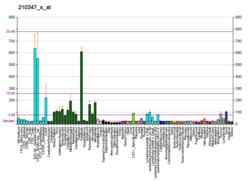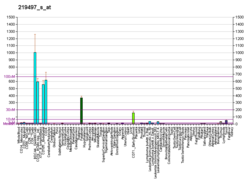| BCL11A |
|---|
|
| Identifiants |
|---|
| Aliases | BCL11A, B-cell lymphoma/leukemia 11A |
|---|
| IDs externes | OMIM: 606557 MGI: 106190 HomoloGene: 11284 GeneCards: BCL11A |
|---|
| Position du gène (Homme) |
|---|
 | | Chr. | Chromosome 2 humain[1] |
|---|
| | Locus | 2p16.1 | Début | 60,450,520 bp[1] |
|---|
| Fin | 60,554,467 bp[1] |
|---|
|
| Position du gène (Souris) |
|---|
 | | Chr. | Chromosome 11 (souris)[2] |
|---|
| | Locus | 11|11 A3.2 | Début | 24,078,056 bp[2] |
|---|
| Fin | 24,174,123 bp[2] |
|---|
|
| Expression génétique |
|---|
| Bgee | | Humain | Souris (orthologue) |
|---|
| Fortement exprimé dans | - éminence ganglionnaire
- primary visual cortex
- Brodmann area 23
- skin of hip
- skin of thigh
- gyrus temporal moyen
- gyrus postcentral
- Region I of hippocampus proper
- ventricular zone
- gyrus frontal supérieur
|
| | Fortement exprimé dans | - Rostral migratory stream
- barrel cortex
- éminence ganglionnaire
- Cortex piriforme
- gyrus précentral
- Subiculum
- medial ganglionic eminence
- Tubercule olfactif
- subdivision of hippocampus
- Region I of hippocampus proper
|
| | Plus de données d'expression de référence |
|
|---|
| BioGPS | 

 | | Plus de données d'expression de référence |
|
|---|
|
| Gene Ontology |
|---|
| Fonction moléculaire | - protein homodimerization activity
- liaison ion métal
- RNA polymerase II cis-regulatory region sequence-specific DNA binding
- DNA-binding transcription repressor activity, RNA polymerase II-specific
- liaison protéique
- protein heterodimerization activity
- Fixation d'acide nucléique
- DNA-binding transcription factor activity, RNA polymerase II-specific
- DNA-binding transcription factor activity
- protein kinase binding
- sequence-specific DNA binding
| | Composant cellulaire | - cytoplasme
- nucléoplasme
- noyau
- postsynaptic density
| | Processus biologique | - negative regulation of protein homooligomerization
- negative regulation of neuron projection development
- regulation of transcription, DNA-templated
- regulation of dendrite development
- negative regulation of transcription by RNA polymerase II
- positive regulation of collateral sprouting
- Sumoylation
- transcription, DNA-templated
- negative regulation of collateral sprouting
- positive regulation of neuron projection development
- negative regulation of axon extension
- transduction de signal
- positive regulation of transcription by RNA polymerase II
- neurogenèse
- negative regulation of dendrite development
- positive regulation of gene expression
- negative regulation of dendrite extension
- negative regulation of neuron remodeling
- cellular response to L-glutamate
- negative regulation of branching morphogenesis of a nerve
| | Sources:Amigo / QuickGO |
|
| Orthologues |
|---|
| Espèces | Homme | Souris |
|---|
| Entrez | | |
|---|
| Ensembl | | |
|---|
| UniProt | | |
|---|
| RefSeq (mRNA) | NM_018014
NM_022893
NM_138553
NM_138559
NM_001363864
|
|---|
NM_001365609 |
| |
|---|
NM_001159289
NM_001159290
NM_001242934
NM_016707 |
|
|---|
| RefSeq (protéine) | |
|---|
NP_060484
NP_075044
NP_612569
NP_001350793
NP_001352538 |
| |
|---|
NP_001152761
NP_001152762
NP_001229863
NP_057916 |
|
|---|
| Localisation (UCSC) | Chr 2: 60.45 – 60.55 Mb | Chr 11: 24.08 – 24.17 Mb |
|---|
| Publication PubMed | [3] | [4] |
|---|
|
| Wikidata |
| Voir/Editer Humain | Voir/Editer Souris |
|
Le BCL11A (pour « B-cell lymphoma/leukemia 11A ») est un facteur de transcription dont le gène est BCL11A situé sur le chromosome 2 humain.
Rôles
Il augmente l'activité des Bcl-2, BCL2-xL et MDM2, et par ce biais, est un inhibiteur du P53[5].
Il inhibe la production d'hémoglobine fœtale[6] et stimule la prolifération des lymphocytes[5] ainsi que des cellules dendritiques plasmacytoïdes[7].
En médecine
La délétion du gène est responsable d'un syndrome associant la persistance d'un taux élevé d'hémoglobine fœtale ainsi que des troubles du spectre autistique.
Une mutation du gène est associée avec un risque plus important de schizophrénie[8] ou de trouble du déficit de l'attention avec ou sans hyperactivité[9].
L'inhibition du gène permet une augmentation de l'hémoglobine foetale et peut constituer ainsi une voie de traitement pour la drépanocytose[10] ou la bêta-thalassémie[11].
Voir aussi
Notes et références
- ↑ a b et c GRCh38: Ensembl release 89: ENSG00000119866 - Ensembl, May 2017
- ↑ a b et c GRCm38: Ensembl release 89: ENSMUSG00000000861 - Ensembl, May 2017
- ↑ « Publications PubMed pour l'Homme », sur National Center for Biotechnology Information, U.S. National Library of Medicine
- ↑ « Publications PubMed pour la Souris », sur National Center for Biotechnology Information, U.S. National Library of Medicine
- ↑ a et b Yu Y, Wang J, Khaled W et al. Bcl11a is essential for lymphoid development and negatively regulates p53, J Exp Med, 2012;209:2467–2483
- ↑ Sankaran VG, Menne TF, Xu J et al. Human fetal hemoglobin expression is regulated by the developmental stage-specific repressor BCL11A, Science, 2008;322:1839–1842
- ↑ Ippolito GC, Dekker JD, Wang YH et al. Dendritic cell fate is determined by BCL11A, Proc Natl Acad Sci U S A, 2014;111:E998–E1006.
- ↑ Basak A, Hancarova M, Ulirsch JC et al. BCL11A deletions result in fetal hemoglobin persistence and neurodevelopmental alterations, J Clin Investig, 2015;125:2363-2368
- ↑ Hinney A, Scherag A, Jarick I et al. Genome-wide association study in German patients with attention deficit/hyperactivity disorder, Am J Med Gen et B Neuropsychiatr Genet, 2011;156B:888–897
- ↑ Esrick EB, Lehmann LE, Biffi A et al. Post-transcriptional genetic silencing of BCL11A to treat sickle cell disease, N Engl J Med, 2021;384:205-215
- ↑ Frangoul H, Altshuler D, Cappellini MD et al. CRISPR-Cas9 gene editing for sickle cell disease and β-thalassemia, N Engl J Med, 2021;384:252-260
 Portail de la biologie cellulaire et moléculaire
Portail de la biologie cellulaire et moléculaire  Portail de la médecine
Portail de la médecine
 Portail de la biologie cellulaire et moléculaire
Portail de la biologie cellulaire et moléculaire  Portail de la médecine
Portail de la médecine 



















